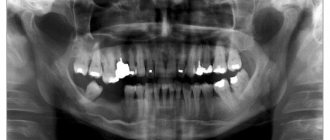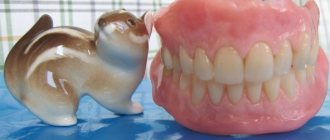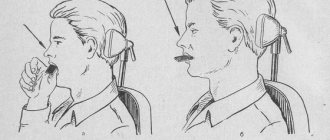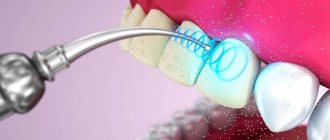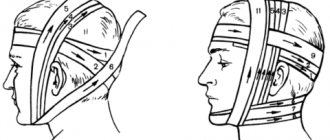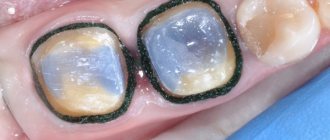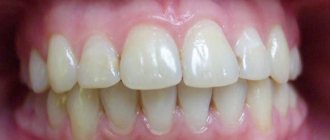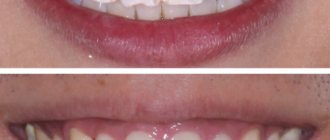Peter Mann (Peter Mann, DDS, FICOI, FAGD), director of the Smile Arts dental clinic (Manhattan, New York), believes that endodontics is a type of treatment that can be systematized and can not only bring constant profits and loyal patients, but also to be a kind of outlet for the doctor, and not a source of constant stress. To do this, you need an appropriate set of tools and a proven sequence of actions that virtually eliminates the occurrence of emergency situations. This material contains all of Peter’s advice, including a list of tools and a step-by-step description of the algorithm.
Tools
Rotary (machine) files Sybron Twisted Files
Peter considers Sybron Twisted Files (TF) to be the “workhorse” in the field of instrumental channel processing. If desired, they can be found in local dental stores, or you can order them on eBay. The advantages of these files are flexibility and a low risk of tool breakage in the canal. When working from the crown down (crown-down technique), in most cases a 0.04 mm file is sufficient.
Manual C files
The only manual files in Dr. Mann's instrumentation are the 12.5mm C-file from Roydent. These are harder to find than the Sybron Twisted Files. Peter uses these files when working with curved and calcified canals. If the degree of calcification is high, it is better to do the treatment step by step, moving gradually. This is where 12.5mm C files come in handy.
Brasseler EndoSequence Files
Brasseler EndoSequence files are used to complete the instrumentation of the canal.
Gates Glidden Bors
Gates Glidden burs are used to create channel access.
Apex locator Morita Root ZX II
Morita apex locators are known to many dentists. According to Peter Mann, an apex locator connected to a low-speed handpiece (endomotor) is a wonderful thing. Morita Root ZX II can detect excess torque (torque) and switch the motor to reciprocal mode when the file is rotated 90 degrees in one direction and the same amount in the other. In this mode, the risk of file breaking is radically reduced. In addition, the connection between the apex locator and the tip allows you to stop in time and not go beyond the apex.
Other tools and aids
- Endo: plugger (dental plugger), probe (explorer), expander (spreader).
- Irrigation: Sodium hypochlorite (NaOCl), 17% EDTA, 2% chlorhexidine.
- Hand-held gutta-percha condenser (an instrument with a heating element).
- Sealer AH Plus.
Main manufacturers
Gates Glidden tools have a tail piece (inserted into a drill) and a rotating drill bit.
The working area is made in the shape of a drop with 3 spiral cutting edges, its length is 2.5-3 mm. The drill is made of a stainless alloy containing chromium and nickel. Gates Glidden used:
- For mechanical expansion of the first third (orifice) of the root canal. The blunt tip of the working part eliminates tooth perforation and provides high-quality access for further work.
- For unsealing and removing fragments of gutta-percha from a previously treated canal.
The Largo end drill has a similar structure, but the length of its working part is 7-8 mm. Has 2 cutting blades in the shape of a spiral.
Largo is used:
- At the initial stage of passage of the canals of the incisors and canines.
- During prosthetics with stump inlays to form an ostial bed.
Endodontic treatment algorithm
Stage 1: access
Before starting work, Dr. Mann usually explains to the patient the need for future restoration of the tooth and thus obtains permission to remove the tooth from occlusion. Then the sequence of actions is as follows.
1. A football bur is used to level the occlusal surface. This step facilitates future access and minimizes postoperative discomfort for the patient.
2. Opening the cavity. A ball bur is used.
3. Search for all channels, for which Explorer is great.
4. Beginning of instrumentation, the first step is expansion of the coronal third and removal of the pulp using a Sybron TF 0.10 rotary file.
5. The canals appear in the field of view, you can proceed to expanding the coronal part with a Gates-Glidden bur. This step allows for adequate instrumentation and irrigation and reduces the risk of file breakage. Access to all channels should be unhindered.
Stage 2: Instrumentation and Irrigation
Irrigation is the most important component of the endo, ensuring predictable performance in the canals. Generous rinsing after each file is a mandatory step. The file cannot clear all the tissue from all the side canals, irrigation helps solve this issue as the solution kills bacteria and dissolves the soft tissue. Dr. Mann's usual recipe is 25 cc per channel, 5 syringes of 5 cc, plus 5 cc of EDTA and 5 cc of 2% chlorhexidine. The sequence of actions at this stage is as follows.
1. Processing with several Sybron TF 25 files with cones from 0.10 to 0.80 and from 0.60 to 0.40. In most cases, a full depth cut will produce a 0.40 file. In wide palatal or distal canals a 0.60 file may be required.
2. Treatment with Brasseler EndoSequence rotary files, crown-down technique, which involves the gradual passage of canals with different files from crown to apex. 3. To ensure that the canal has been penetrated to its full depth, a periapical photograph with gutta-percha should be taken. Using a gutta-percha pin for this purpose is better than using files, as it will not break or bend.
As part of his endodontic algorithm, Peter Mann handles hand files only in cases where the canal is curved or calcified. His choice is C-files (in the Russian-speaking environment, the designation “C-files” is found), which Dr. Mann considers multifunctional and eliminates the need to use other files. If the canal is severely curved and narrow, hand C-files may be the only instrument used, meaning no machining is performed at all.
Stage 3: obturation
Dr. Mann's suggested sequence for this step is as follows.
1. First, dry the canals thoroughly with paper points.
2. Then you need to insert a gutta-percha pin with a sealer applied to it (AH Plus) into the canal, push it to the entire working depth and remove it.
3. Next, you need to apply more sealer to the same pin and insert it into the canal not in one movement, but in several successive presses, each of which pushes the pin a little deeper. In this case, after each press you should move the pin back a little. This ensures complete filling of the canal with sealer and sealing of the apex.
4. The next step is cauterization of gutta-percha in access to the canal. During the process, you should lightly press the capacitor.
Gates-Glidden type bur
(gates-glidden drill, reamer “G”; from the English gate - gate; glide - sliding) has a short teardrop-shaped working part on a long thin rod; manual or equipped with a shank for a contra-angle handpiece. It is a rotary tool (recommended rotation speed is 450-800 rpm). Provides better access to the canal, expands its mouth and coronal part. Many instruments of this type have a safety (blunt) tip. The length of the working part with the rod is usually 15-19 mm; sizes - 50 (No. 1), 70 (No. 2), 90 (No. 3), 110 (No. 4), 130 (No. 5), 150 (No. 6).
Reamer type Peeso (Largo)
(peeso reamer) is equipped with an elongated working part that turns into a rigid rod. Used in rotary mode (recommended rotation speed - 800-1200 rpm) and equipped with a shank for a contra-angle handpiece. It is used after the formation of the tooth cavity to develop the straight part of the canal, straightening, opening the mouths, and preparing the canal for pins. Some have a safety tip. The length of the working part with the rod is usually 15-19 mm; sizes – 70 (No. 1), 90 (No. 2), PO (No. 3), 130 (No. 4), 150 (No. 5), 170 (No. 6).
Instruments for widening canal mouths
Canal mouth expander
(orifice opener (widener)). It is a hand or machine tool with a uniformly tapering faceted working part. Used in straight sections of the canal, to expand the mouths (in rotational mode). Effective in molars where it is difficult to work with a root bur. Typically available in 3 sizes and 3 lengths (14, 15 and 16 mm). Variety - Orifice Opener MB - with diamond coating of the working part (Maillefer).
Beutelrock reamer type 1 (Bl)
(Beutelrock reamer 1) is a machine tool with an elongated flame-shaped working part and a four-pointed cross-section (with four cutting edges). Used to create and expand access to canals and work in their straight sections (in rotational mode with a recommended rotation speed of 800-1200 rpm). The length of the working part is 11 mm, sizes from various manufacturers are 70 or 90 (No. 1), 90 or 100 (No. 2), 110 or 120 (No. 3), 130 or 140 (No. 4), 150 or 160 (No. 5) , 170 or 180 (No. 6).
Beutelrock reamer type 2 (B2)
(BeuteirocK drill reamer 2) is a machine tool with a cylindrical end, made by twisting a flat blade with two cutting edges. Highly aggressive, works in rotational mode (recommended rotation speed - 450-800 rpm). Expands straight sections of channels. The length of the working part is 18 mm. Usually it has the following sizes - 30 (0), 35 (No. 1), 45 (No. 2), 60 (No. 3), 75 (No. 4), 90 (No. 5), 105 (No. 6).
see also
Conclusion There are different concepts about the causes of manic-depressive psychosis, but most authors believe that the main reason is the inferiority of the organism itself.&nbs...
The influence of bismuth on the human body and life Bismuth (lat. Bismuthum) is a chemical element of group V of the periodic system of Mendeleev with atomic number 83. Bismuth is a fragile, fusible metal of silver-white color with a pink tint ...
Conclusion Having examined in detail the known methods for identifying various microorganisms, we can conclude that this is basically a long and labor-intensive process that requires a sufficient set of knowledge, equipment ...
Possible problems and ways to solve them
File fragment
File breakage in a canal is probably the most common problem dentists encounter when working in canals. To avoid, Dr. Mann recommends
- carry out irrigation every time the file is changed,
- do not put pressure on the file, but click on it easily.
If the file still leaves the channel incomplete, you must:
- take a periapical photograph that will show where the fragment is located (there is a high probability that the file broke at the bend of the canal);
- begin the passage of the canal with the 6th or 8th C-file in order to bypass the fragment and reach the apex (the process may take from 30 to 40 minutes, irrigation is required in abundance);
- After passing the canal to its full depth (usually with a 15th C-file), irrigation should be carried out and the canal should be obturated.
Leaving the fragment in the canal and using it as part of a filling is a logical solution. At the same time, sometimes as a result of abundant irrigation, the fragment can come out.
Sodium hypochlorite damage
If sodium hypochlorite gets behind the apex, which may be the result of improper instrumentation, swelling will immediately appear on the patient's face. In this case, the procedure may be as follows.
1. Irrigate immediately with saline solution.
2. Make a cold compress and apply it to the swelling.
3. Prescribe pain medication and antibiotics to the patient, explaining the situation and emphasizing the fact that he will be fine.
In such cases, a good relationship with the patient is especially important.
Many patients ask many questions and strive to understand the dentist's actions. If you decorate the walls of your clinic with dental posters from Stomanet.ru, they will be able to obtain the required information without your participation.
https://lavka.stomanet.ru
What does it look like? Here is an example from Krasnodar:
And here are dental posters in beautiful frames that decorate the walls of clinics in Tobolsk:
(click on photos to enlarge them)
Delivery within Russia is free. We accept payments from legal entities.
Go to the store
Based on the material
Step-by-step procedure to simplified and efficient root canal techniques
